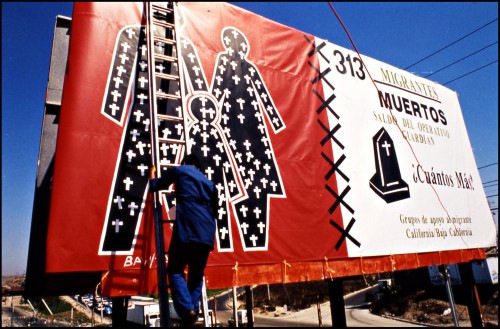
Tanya Aguiñiga and Michael Schnorr. “Cuantos Mas?,” Chicano Park. San Diego. Photo courtesy of Tanya Aguiñiga, BAW/TAF. 1998-2001.
As an artist who grew up crossing the Tijuana/San Diego border every day – Tanya Aguiñiga’s life and career is often punctuated with the “/.” Although her work takes on many forms, ranging from installation, fully functional high-end furniture, hand-made apparel, accessories, social practices and performance – the continuous thread of her transnational autobiography runs through her descriptions of all of it.
I had the pleasure of meeting with Tanya for a lengthy biographical interview in her studio, situated in Atwater Village, down the street from her home near the LA River. Because of the way that she incorporates autobiography in her work, I asked her to start at the beginning. “I was born in 1978 in San Diego, California but raised in Tijuana. I lived in Tijuana and went to school in San Diego starting at the age of four. I crossed the border every day for fourteen years. So that’s a big part of my story, my influences and my approach to art making.”

Tanya Aguiñiga and Michael Schnorr. “Cuantos Mas?,” installation in Tijuana. Mexico. BAW/TAF. November 1998. Photo courtesy of Tanya Aguiñiga.
Tanya began working as an artist while studying theater at Southwestern College in Chula Vista. By chance, she met her first arts mentor there, artist Michael Schnorr, a muralist and one of the founding members of the internationally-renowned collective Border Art Workshop/Taller de Arte Fronterizo (BAW/TAF). BAW/TAF was founded in the 198os with artists David Avalos, Victor Ochoa, Isaac Artenstein, Jude Eberhart, Sara-Jo Berman, and Guillermo Gomez-Peña, who were challenging systematic oppression along the US-Mexico border through performance, installation, and publications on a local and international scale.
“I took a film class with Michael and just immediately connected. Not like network-style, but like connections to each other. He was doing a bunch of migrants’ rights work and I had never taken a painting class—I had never done anything . . . I think he immediately saw something in me and he asked me if I wanted to help in some of the anti-Operation Gatekeeper work that he was doing.”
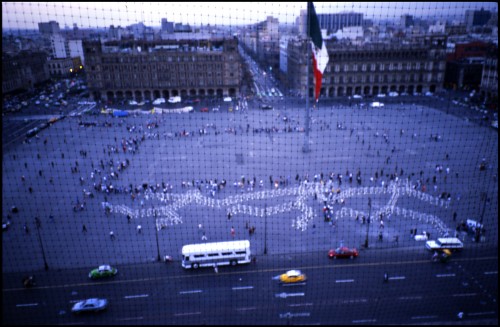
Tanya Aguiniga and Michael Schnorr. “Death Toll,” 2000. Installation and public art performance, Senate Building Mexico City, MX; Federal Cultural Center, Tijuana, MX; National Council de la Raza, San Diego, CA; Federal Courthouse, San Diego, CA; National MECHA Conference, San Diego, CA. Photo courtesy of Tanya Aguiñiga.
Shortly after meeting Michael in 1997, Tanya made the decision to study furniture making at San Diego State. While studying furniture under Wendy Maruyama, she worked in the department woodshop, held a full-time job at the San Diego Art Museum, and was involved with various art/activism missions as part of the BAW/TAF. Tanya describes her education as a “three-pronged approach to art-making. I was always really aware of the fact that it was all related and it was all different aspects of art-making that I really enjoyed.”
The fact that Tanya is highly adaptable is perhaps one of the qualities Michael saw in her when he invited her, at the age of 18, to become an active member of the BAW/TAF, an experience which has had a lasting impact on both her work and her teaching style, which she describes as being very one-on-one even in a classroom of multiple students. Tanya and Michael remained friends for more than 15 years, and she is still visibly shaken when she discusses the recent death of her friend/teacher. Michael committed suicide in July of this year.
Michael initiated Tanya into the BAW/TAF by assigning her the task of reviewing the organizational archives, comprised of bookmarked magazines, performance documentation and assorted newspaper clippings — then asking her if she would like to participate once she had finished. Her answer was yes. “I had only been out of high school for a year. I immediately dove head-first into that whole world.”
Tanya declares that she never held a drill before she met Michael. In 1997, during her second week of working as part of the BAW/TWF, he put her in charge of building a new roof for Aguascalientes, the arts community center in Maclovio Rojas. Maclovio Rojas is a completely autonomous community on the outskirts of Eastern Tijuana, near Tecate, which was founded and operated by women.
Tanya describes the town, which has left an indelible imprint on her, thusly: “The only other communities that are autonomous are all Zapatista communities. They had ties to Zapatistas from the beginning. All of these women settled this land that was in the middle of nowhere and then slowly all these factories, all the maquiladoras, started building around them. Hyundai, Samsung, Panasonic, all these different companies started surrounding them. The land became much more valuable than it ever was. The Mexican government wanted to brutally force them out of this land so they could sell it because it had become more valuable. According to Mexican agrarian reform law, if you’ve been squatting on a piece of land for more than ten years and nobody’s claimed it, it’s legally yours. It was their legal ground to stay, because they’d been there that long. But the government didn’t want them to stay there — so they didn’t have access to water, electricity, hospitals, police, no services. At the same time, the government was putting chains around people’s houses, yanking them out, setting houses on fire, attacking the women and children while the men were at work, and constantly trying to put the community leaders in jail.”
According to Tanya, BAW/TAF had chosen to work with Maclovio Rojas at the time of these attacks, to bring the national and international attention to what was happening there. They were impressed by the community’s capacity to self-govern–each block had a captain who designated certain areas for farming, others for living, caring for each other while engaging in self-defense against the national government. “We knew that at some point it was going to be connected to the rest of Tijuana and that this road there was going to turn into this larger highway system. And so we thought if we could help train people in hand crafts or in different things they could make a living if they started setting up businesses around that road. We ended up building a sculpting school, a cemetery, a secondary school, all these different buildings…Through doing art-based projects we couldn’t get in trouble by the Mexican government as well. But a lot of them were building projects–more than just arts-based projects. We started with the building of the community center. That was just to do arts classes for kids, English classes for kids, reading classes for kids, but then also job training for a lot of the women so that they would have alternatives to working in the factories.”
Tanya admired the resourcefulness of the builders. “The community was all made out of trash from the U.S. American people would get rid of garage doors as they upgraded to automatic or mechanical doors. Then all the wood doors end up in Mexico, and cost 16 dollars per door–buy five of them and you have a house. That was really interesting to us–this history of what happens when gentrification starts to take over parts of Southern California, as people feel the need to change their lifestyles.”
Tanya quickly became more deeply entrenched in the co-mingling of art and civic duty in Macliovo Rojas. Over the four years of her involvement in the BAW/TAF, from 1997-2003, she would oftentimes independently haul telephone poles and other supplies in a non-commercial transport system comprised of a boat trailer hitched to Michael’s Ford Ranger while he was traveling elsewhere for work. She taught art and language courses at the community center, ran a sports program, and designed a fountain for the cemetery. All the while, she and Michael worked on large-scale collaborative memorial installations which addressed the human impact of the Clinton Administration Operation Gatekeeper along the border, and in Mexico City. When she was twenty years old, she and he served on a panel with Lucy Lippard called “Dem.art.cracy: Art in a Social Context” before she had even had the chance to discover Lippard’s work. She even paused her graduate school interview at RISD to field a phone call in order to mediate a dispute in Maclovio Rojas over the ownership of a piece of wood.
She became concerned that the community was no longer as independent as when the project had first begun. “I was just running all kinds of random stuff and in charge of so many building projects. Nobody was helping anymore. It became this really romantic idea of community work, and I think that in many ways we enabled more than we empowered. So I had to step away.”
Tanya describes her work as cyclical. After studying at RISD, and traveling to numerous residencies including the Native Arts Center in Alaska, she returned Southern California and recommenced collaborative artmaking in her studio with the help of her artist sisters Karla and Marissa Aguiñiga, and others. During the course of her studies she developed a fascination with wool, felt, rope and other hand-processed textiles produced by artisans around the world. As part of this research, she returned to Mexico to collaborate with Mayan backstrap weavers in the Chiapas on a textile skills exchange. This collaboration resulted in a series of sale-able objects for various markets, many of which were on view at JF Chen in Hollywood in November featuring the premier of the episode of Craft In America featuring Tanya.

Tanya Aguiñiga weaving in front of the Beverly Hills sign, June 2012. Photo courtesy of Tanya Aguiñiga and KCET Artbound.
Working on the Chiapas project also resulted in a series of politically-charged public weaving performances for KCET Artbound. The first performance nearly resulted in her arrest on Rodeo Drive for setting up a loom in a metered parking space in front of the Yves Saint Laurent store. The second piece, Felt Me, was an emotional and physical endurance test, engaging her sisters, friends and studio workers in felting her entire body. “I know that people care, that people respond well to the work I’m doing, and it’s really rewarding for me, the more I’m not just making furniture–it goes back to what I was really passionate about. After Michael passed away, I was like, ‘I need to do this.’ In many instances I’ve come out of traditions and lineages of amazing people that have helped me become who I am.”


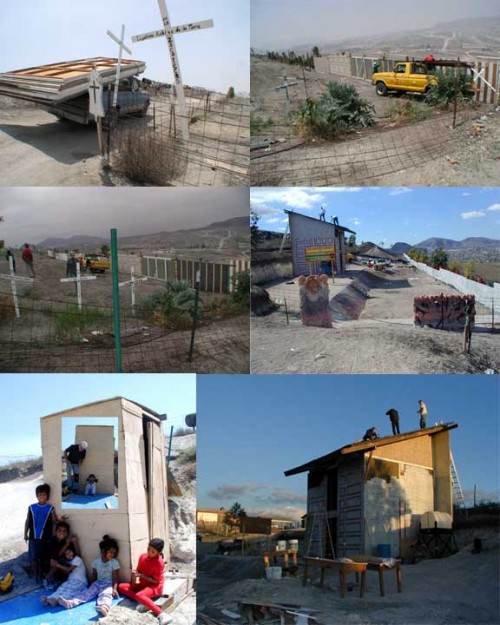
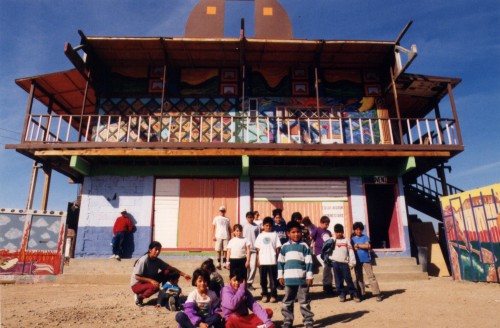
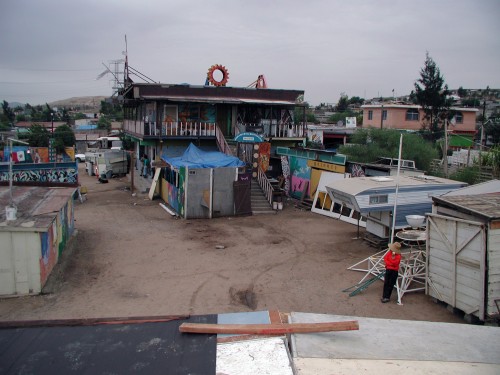
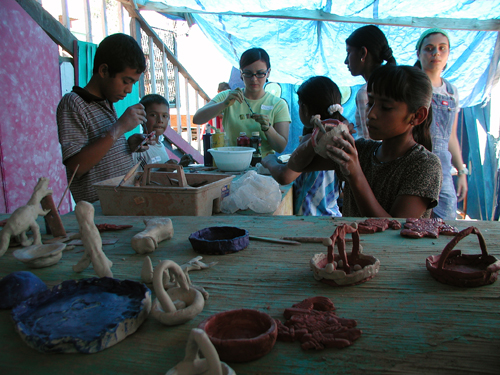
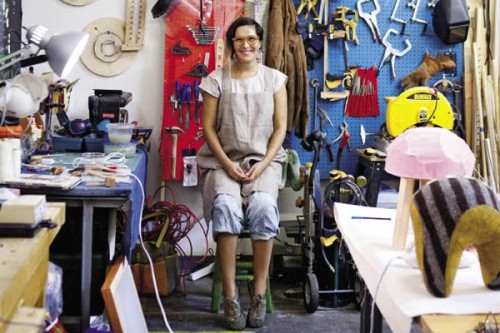
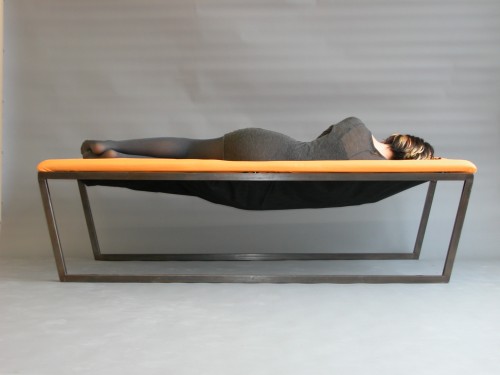
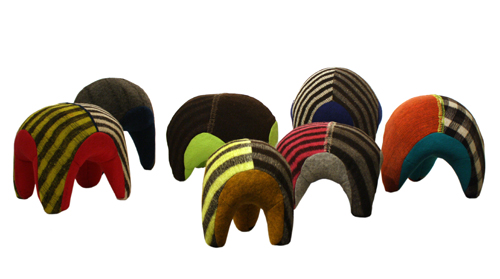




Pingback: » Art 21 Magazine